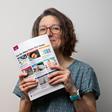Join the IOP’s Charles Tracy and RSC’s Izzi Monk as they discuss the similarities and differences in reasoning and learning between the sciences
Physics and chemistry are distinct sciences, yet often students learn ‘science’ until their middle years at secondary school. In this article, the IOP’s Charles Tracy and RSC’s Izzi Monk explore whether chemists and physicists think differently and if there are any distinctions in their approach to work in the classroom and the lab. The article also discusses the importance of scientific skills in life – regardless of further study or career– such as scientific literacy and problem solving.
Do chemists and physicists think differently?
Charles Tracy: Yes. And that’s a good thing.
I think the differences between the disciplines is more than the fields of study. I’d say that both the ways of thinking and the motivations are probably different as well. The most noticeable difference might be that the models in physics are, in the end, expressed mathematically. Physics is absolutely loaded with quantities and much of the time, physicists are either looking for or relying on tightly defined predictive relationships between those quantities. And, importantly, having done so, they will try to understand, at the deepest level possible, the reasons for that relationship.
I’m interested to hear how much you think chemistry is different from physics; and what its characterising features are.
Izzi Monk: We use the expression ‘linked, but distinct’. We would say chemists have distinct ways of understanding the material world. But equally, all three sciences share many similarities. It’s important to identify those similarities to allow connections to be made from chemistry to the other sciences so students come to appreciate both the interconnectedness of chemistry, and the multidisciplinary nature of many issues and advances. Equally though, disciplinary identity is important because being able to explicitly recognise scientific disciplines at school level is essential for learners to make informed choices about further study and careers. They need to know whether they find the subject interesting, useful and enjoyable.
CT: Good. I’m glad we agree physics and chemistry are different in some ways. ‘Linked, but distinct’ is a good phrase.
One of the reasons I think we know they’re distinct is that people do choose between them, and quite easily. I think students decide quite early on whether they lean towards physics, chemistry or biology. When taught well, students quickly get a sense that there are differences (even if they couldn’t describe the distinction) and which ways of thinking most appeal to them. And they gravitative towards their preferred area of science.
IM: Yes, this is where highlighting the disciplinary identity is really important.
CT: Yes; it’s a worry that, up to age 16, it’ll be the case that a lot of people don’t see that, because the disciplines are not taught separately, and students may not have the individual, authentic experiences. This can make it hard for them to make informed choices for post-16 study. Nevertheless, at A-level, within one or more of the sciences, they will start to say to themselves, ‘I like this way of thinking. It’s not that I like chemicals, or I like circuits. It’s that I like this discipline.’
When considering what subjects to study post-16, are students already thinking about what they’re going to do once they finish school?
IM: The ASPIRES research indicates students’ from aspirations to be scientists early on. We are concerned students don’t necessarily understand the career opportunities chemistry can offer, and this may be impacting student entry numbers to further study and careers. We think it’s important that young people understand the value of chemistry to society and how this relates to careers in the chemical sciences, so we would like to see this embedded in the curriculum and teachers supported with resources and professional development opportunities.
When we talk about making sure students leave school scientifically literate, what do we mean?
CT: That’s a very good question.
We want students to have a deep sense that the sciences have all contributed in a major way to human knowledge and to humankind. They have led to improvements in our quality and length of life. It’s important that students know that in a historical sense, and also that they have a lasting belief that the sciences will continue to contribute positively to the way they live.
In terms of the disciplinary knowledge, they should leave with both a capability in some of the ways of thinking and a sense of the reliability of scientific knowledge because it is founded on the ways of thinking that they have experienced.
First, on developing their own disciplinary knowledge, this will provide them with the transferrable and highly valued capabilities of the sciences; and will therefore always be useful to them as individuals. Developing their disciplinary knowledge and giving them those lasting and transferrable capabilities is a big contribution that an education in the sciences can give students (both those who continue in the sciences and those who don’t). And this contribution is turbo-charged if they develop not just one set, but three sets of thinking that are very powerful.
The second role of developing disciplinary knowledge is what education academics call the epistemic knowledge: that school leavers understand how scientific knowledge iwas and is derived so that they trust in that knowledge; and they feel content that what they have learned in the sciences is not whimsical or haphazard. For example, the established fact that the temperature of the globe is rising is not someone’s view or opinion. Scientists have used very, very careful techniques to measure this over a number of years and establish the pattern; and they have gone further, they have described, explained and modelled the mechanisms that have caused these changes. In this example – and others – we want school leavers to trust the outputs of science; and they can develop that trust through learning and employing its practices and ways of thinking for themselves.
IM: I think we would echo that. We want the curriculum to provide students with the skills and understanding to appreciate the role of chemistry, and more broadly the sciences in society.
Models are often used to teach tricky concepts, and they’re also used in ‘real’ science. How do you navigate the differences and similarities between models in teaching and in ‘real’ science?
IM: Chemists use models to understand the world and to increase understanding. In the current curriculum we use a succession of atomic models, but I’m not sure all students really appreciate why they’re used and why different ones might be used in different situations. The classic one I experienced when I was teaching chemistry was the atomic models at GCSE and A-level. Some students at A-level had the idea that what they had been taught at GCSE about atoms was ‘wrong’, so I had to explain that it was an appropriate model for what was being explained at the time.
CT: I think that saying ‘what you were taught last year was wrong’ is unhelpful, because that’s frustrating for students. It would be less dispiriting to say: what you were taught last year was a good explanation for what we were describing at the time and remains a good explanation for that. And what we’re teaching you now is the development of that.
For example, year 8s might be taught that current is proportional to voltage and gives a straight-line graph. And this phenomenon is called Ohm’s law. But that’s only for some conductors. It’s not really a law – more like a handy way of classifying conductors into Ohmic and non-Ohmic. So, there’s a risk that, in later years, students get the message that Ohm’s law is wrong. Maybe the trick is to tell them up front that it isn’t really a law – it’s a description of the behaviour of some (Ohmic) conductors.
Thinking with models is a good skill to have. And therefore, if you were taught to think with a model, that was a useful piece of learning in and of itself. Even if it was just for one circumstance, it was still a good thing to teach. Therefore, to say to children ’what you learned last year was wrong’, is itself wrong. What they were taught was right because the model helped them think and develop that powerful capability.
How is the concept of thinking like a scientist, something that appears in many curriculums and exam specifications, relevant to students going on to apprenticeships, for example?
IM: In terms of parity of esteem, it’s really relevant. Apprenticeships are really important for our sector, and so to be able to think as a chemist, biologist or physicist is really important. Again, it goes back to all students appreciating how scientists understand and think about the world.
CT: Yes, I absolutely agree. It may not necessarily relate to their work directly, but these ways of thinking are just good skills to have. If you can explain what’s happening in an electric circuit in terms of forces on electrons, that means you’re explaining an observable phenomenon, in terms of the behaviours of things you can’t see, which is kind of what a lot of science and physics explanations are based on. So, when you come to a problem about developing a vaccine, or to any other problem in life or in work, that ability to conceive of something you can’t see, the skill to be able to explain a phenomenon in terms of constituent parts of a system that you can’t see is really a big capability. And it can be applied to banking, building, economics and electrical safety. It is a generalisable and powerful skill.
IM: Presumably, aside from the sciences, other subjects have different ways of thinking about the world and approaching problems. And that’s a potential advantage of interdisciplinarity, isn’t it? You can draw on these ways of thinking about the problem.
What are the impacts of a narrowly focused curriculum, for example students having to choose subjects midway through secondary school?
IM: Compared to other education systems around the world in terms of the narrowing of subject choices, England, Wales and Northern Ireland are outliers. For the sciences, the RSC is concerned that, in some nations, students have two routes through the sciences up to 16. We – the RSC and sister socieities – all think there should just be one route through the sciences up to 16.
And it would be preferable to call that route ‘the sciences’ rather than ‘science’ to emphasise the plurality and the fact they should be taught as distinct disciplines rather than all being taught by one person or taught as an amorphous entity. But the challenge is curriculum time. We are proposing that there should be a single route, the three subjects are taught separately, so they wouldn’t all be full GCSEs. This route would have the features of triple science without necessarily being three certificates: students would be taught by someone with subject expertise and who could demonstrate the disciplinary ways of thinking within that subject, each discipline would have its own grade in the qualification, and each one would have its own identity on the timetable.
CT: I agree. There is also a paucity of technical education up to 16 – for all students – which contributes to it being viewed as the poor relation of academic success. Those who end up taking an academic path at 16 just drop all technical subjects. And there’s actually very little technical stuff before 16 as well. We focus on the academic, and then we say to people who don’t do so well, ’perhaps you should think of a technical route’, and then we wonder why they’re not given parity of esteem. Whereas the ability to work with your hands and solve problems in a technical way is a hugely important capability – with equal value to academic capability. Therefore, developing technical capabilities should be a valued entitlement for everyone whatever path they’re taking.
IM: Absolutely, the technical and academic pathways should have parity of esteem and there needs to be a coherent landscape at post-16. It shouldn’t be viewed as one route is superior or inferior to another. They should have parity because both routes are really important for the sector and society in general.
However, understanding what the technical qualifications offer in the landscape for employers and further education institutions, and just society more widely, is really important. Do people know what the new T-level is about, for example, and what it can offer?
Charles Tracy studied physics and then did a PGCE in physics. He went on to teach physics at secondary schools, before becoming head of education at the IOP. Charles is now the IOP’s senior advisor for learning and skills.
Izzi Monk did a PGCE and then a master’s in education. She taught science in secondary schools, then joined the RSC as an education policy specialist. Izzi currently works for the RSC as a policy adviser on the environment.












1 Reader's comment